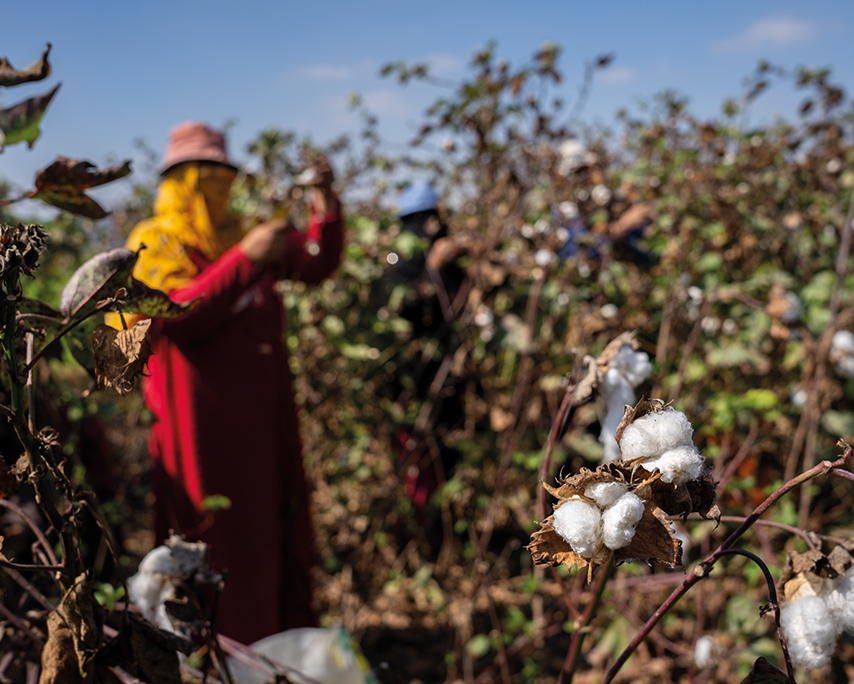Farmers gather to harvest cotton during the Egyptian cotton harvest season, which runs from September to November.
Photo Credit: Ahmed Gamal/NurPhoto via Getty Images
World Cotton Day
Why documenting cotton farming in Africa matters
Cotton farming has long held a central place in Africa’s agricultural and economic history. From the colonial period to the early decades after independence, cotton was promoted as a key cash crop capable of driving industrialisation, providing export earnings, and sustaining rural livelihoods. In countries such as Kenya, Tanzania, Uganda, Mali, and Zambia, cotton fields supported households and fed local textile industries. Yet today, cotton farming across much of the continent faces serious challenges, with many regions experiencing decline.
Understanding this story requires more than statistics. It calls for the systematic documentation of both failures and transformations within cotton farming. Such records matter for farmers, policymakers, researchers, and future generations. Importantly, there is also a need to consolidate knowledge across countries so that lessons learnt in one region can strengthen strategies in another.
One of the main reasons for documenting the decline of cotton farming is economic learning. Many cotton-growing countries have struggled with pricing policies, lack of subsidies, weak supply chains, and collapsing textile industries. The import of second-hand clothing, combined with fluctuating global prices, further reduced incentives for local farmers. By recording these challenges in detail, countries can better understand the structural weaknesses in their agricultural systems and design stronger recovery strategies.
However, if this documentation remains siloed within national borders, its value is limited. A more effective approach is to consolidate this information into shared continental databases or regional research hubs. For instance, if Zambia documents the success of farmer cooperatives or Mali maps out the benefits of subsidies, these insights could guide Kenya or Uganda as they reevaluate their cotton policies.
Cotton is not only an economic crop but also a part of the social fabric of many communities. For decades, it influenced family livelihoods, local economies, and even gender roles. Documenting its decline reveals how households adapted, whether by switching to alternative crops, joining informal labour markets, or migrating to urban areas.
When these stories are brought together from across countries, they create a richer understanding of rural resilience in Africa. Consolidating oral histories, farmer testimonies, and cultural experiences into continent-wide archives allows policymakers, civil society groups, and educators to see patterns that no single country could capture on its own. The information gathered from the patterns helps Africa develop context-sensitive solutions that honour local realities while strengthening regional solidarity.
Cotton is a resource-intensive crop that often requires large amounts of water and pesticides. Over time, this has led to soil degradation and environmental strain in many farming areas. Documenting these effects highlights the ecological costs of cotton farming. At the same time, new approaches such as organic cotton and more sustainable practices are emerging.
By pooling environmental data across countries, Africa could build a stronger case for global climate finance and sustainable trade partnerships. Shared documentation enables governments to present a united voice in negotiations on sustainability and fair trade, making the continent more influential in shaping global agricultural standards.
Weak governance has played a significant role in the decline of the cotton industry. Poorly managed cooperatives, corruption in marketing boards, and inconsistent government support discouraged many farmers. Documenting these issues provides evidence of where reforms are needed. But if each country documents governance failures in isolation, the learning is incomplete.
A consolidated platform of policy experiences, both successes and failures, would allow African governments to benchmark against one another and avoid repeating mistakes. Regional institutions, such as the African Union or economic blocs, could facilitate this exchange, transforming fragmented knowledge into a continental asset.
The story of cotton farming in Africa is not finished. While some regions continue to struggle, others are exploring new models of production and trade. Demand for sustainable textiles and ethical fashion creates opportunities for African cotton, provided it is managed responsibly. To seize these opportunities, Africa must not only document cotton’s journey but also consolidate country-level knowledge into continental strategies. Shared data, cultural insights, environmental lessons, and governance experiences can collectively strengthen Africa’s position in global markets.



